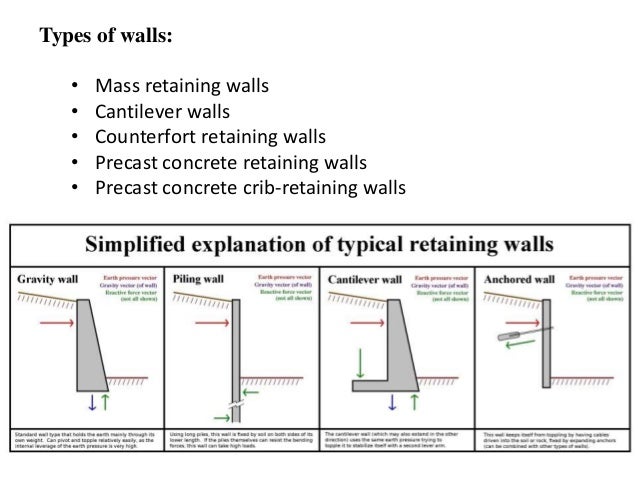All About Ace Construction Company Texas
Table of ContentsThe Ace Construction Company Austin PDFsAll About Construction Company AustinConstruction Company Austin - An OverviewThe Best Guide To Austin Construction Company
Given that these materials can not withstand appreciable stress, the design focuses on avoiding tension in the wall. Some gravity walls do not utilize mortar, relying entirely on their weight to remain in place, as when it comes to dry stone walls. These walls normally are trapezoidal in section as displayed in Fig.
2. Gravity walls require heavy foundation due to the big size of the wall. They are cost-effective and suitable for only small heights. A gravity keeping wall provided with a little quantity of reinforcement for lowering the mass of the concrete is understood as semi-gravity keeping wall, as displayed in Fig.
3. The lateral earth pressure is principally withstood by the mass of the wall, as in the case of a gravity keeping wall. These are the enhanced concrete walls in which lateral earth pressure is withstood by structural action of its members. The base of the wall is extended into the backfill on the heel side and is referred to as heel slab, as revealed in Fig.

Examine This Report on Austin Construction Company
The heel piece and the toe piece undergo resultant upward soil pressure from the bottom and bend up. Support is for that reason offered on the tension side, that is, vertically on the behind of the stem and horizontally at the bottom of the heel piece and the toe slab.
Cantilever retaining walls appropriate for keeping the backfill to moderate heights of 4-7 m. In sample, most cantilevered walls appear like "L" s or inverted "T" s. austin construction company. Where foundation soils are bad, earth tieback keeping walls are another option. These walls are counterbalanced not just by a large base but likewise by a series of horizontal bars or strips extending out from the vertical surface area into the backfill.

16. 5. The stem and the heel piece serve as constant slabs covering horizontally along the length of the wall in between the counterforts. Using counterforts lowers the flexing minute due to earth pressure and for this reason the size and support of the stem and the heel piece. Counterforts undergo tension due to the action of lateral earth pressure of the backfill on the stem.
What Does Austin Construction Company Mean?
Figure 16. 6 reveals an upheld keeping wall. The structural action of the stem is the same as in a counterfort maintaining wall. However, the heel slab acts as a cantilever piece as in a cantilever keeping wall. The toe slab functions as a continuous piece covering along the length of the wall between the buttresses.
ADS: Sheet stacks are flexible maintaining structures utilized to provide a short-lived building and construction area for building and construction of structures. Sheet piles are made of timber, steel, or in some cases enhanced concrete. Lumber sheet piles were utilized in the past but their reuse is restricted for momentary structures up to shallow depth (Ace Construction Company Austin). For very important structures and for depth > 3 m, steel sheet piles are more frequently used.
Strengthened cement concrete (RCC) sheet stacks may be often utilized in fine sand or soft clays. RCC stacks might get damaged or broken under driving tensions in stiff soils. Sheet stacks are installed by very first driving the steel or lumber sheets into the soil. The soil on the front side is then dredged (gotten rid of) out.
Private steel sheets are signed up with by ball-and-socket joints to obtain the required length of sheet stacks. A conventional RCC keeping wall obtains its assistance Ace Construction Company Texas mainly from the weight of the wall along with from the weight of the soil maintained above the heel slab. The depth of foundation is generally small, and passive resistance of the soil is typically ignored in the style.
Not known Incorrect Statements About Austin Construction Company
Hence, the depth of foundation (embedment) is big compared to that in a keeping wall. The thickness of sheet stacks is really little compared with the depth and length of a wall. Thus, the weight of a sheet pile is really small and is usually ignored in the style. ADS: The soil on the back of the sheet pile is usually gotten rid of and backfilled with a cohesionless soil.
Nevertheless, the soil listed below the dredge level might be either a cohesionless soil or a cohesive soil, depending on the soil profile at the website of building and construction. Sheet piles having water on the front side used in dock and harbor structures to assist in berthing of vessels (ships) are known as bulk heads.
Standard areas of steel sheet stacks as suggested by United States Steel (1984) are displayed in Table 16. 3. i. Cantilever sheet stack. ii. Anchored sheet pile. The cantilever sheet stack derives its assistance from the embedment into the underlying soil listed below the dredge level, as shown in Fig. 16. 11.
